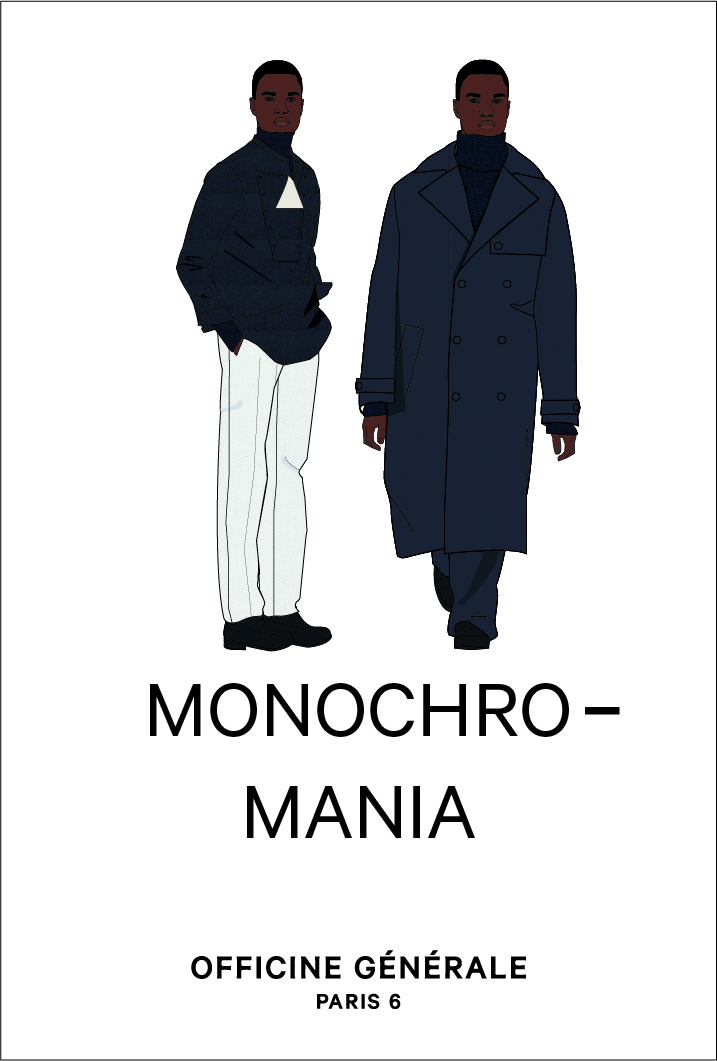The Officine Générale Way
By Paul McLauchlan
Pierre Mahéo is as honest as they come. He will assure you that Officine Générale, his brand, is not the type to make a revolution each season with a sweeping statement of intent. His modus operandi is to tell a new story with different words in the same vocabulary. Mahéo thrives on the minutiae of design, constantly interrogating what makes a specific item worthwhile. Such attention to detail means he has no use for hype and other marketing ploys. This rings true for Fall Winter 2023, a collection that once again advances the Officine Générale narrative: a well-made wardrobe of relaxed tailoring and sportswear that endure in style and quality.
Yet it would be too uncomplicated a task for a designer as shrewd as Mahéo to simply inch forward. Thus there are some notable details. To start, the Frenchman challenged himself to produce a collection limited in its use of colour. The first 25 looks are in navy and the ensuing 25 looks are in gray with various accents. This bears an uncanny resemblance to the designer’s own wardrobe while serving as a mirror through which to refine and perfect the fundamentals of the Officine wardrobe: jersey T-shirts, merino wool jumpers, flannel trousers, denim and leather. There are also some new studies: pants are slightly wider than before; coat lengths extend downwards; jackets don’t necessarily close in conventional ways. The story takes many directions.
“I’m working on the details, finding an evolution, but not revolution,” he said by video from his Paris office, where he was putting the finishing touches on the collection.

What would you like us to know about this collection?
It’s very simple. Last September, Giovanni (who styles the show with me), and my men’s and women’s teams did what we always do. We worked in groups creating colour stories, working on products, and beginning the collection that you see at the show. We took different pieces from the groups and tried to put them together in a lineup. Then, after we brainstormed connecting everything together, I told them I always wanted to do a show which would be very minimal in the use of colour, like a full navy show or a full grey show. Giovanni told me that he loved the idea. The first 25 looks are in navy, and from 26 to 50, it’s the same looks in grey, but with some different accents, some difference. It’s a new exercise for us and it’s not about repeating the same things we were doing. I wanted to test something new. We need to bring something new while keeping in mind who we are and the purpose of our product. It has to be something you can wear.
Your designs are quite personal. How does that inform this collection?
I was visualising my wardrobe – the jacket, the pants, everything – and I’m just wearing navy and grey, basically. So it’s like if you ask Rick Owens what’s in his wardrobe? It’s only black, I guess. So it was very clear to me [how it would look].
Are you using any technologies that contribute to the evolution of your collections?
There are always new materials, but I don’t believe in extremely new fabrics and technologies. We have sampled some, but what I find is that there is a lack of comfort or something that doesn’t match between the looks. I’m always thinking about fabrics in daily use. Are you going to wear it on the subway? Are you going to wear it to dinner? Are you going to wear it from a meeting in the morning to a party at night? I’m very down-to-earth when it comes to the use of fabrics, and I sincerely believe the best fabrics have already been made.
How would you describe your evolution as a designer and brand?
We are not shifting the style season after season. The evolution of the style is important and very personal. You sometimes see designers at the end of a runway show that don’t wear their own collection, designers who have the capability to explore some extraordinary new territories and go in new directions each season. This is not the way I work.
Evolution and improvement are related. What is one essential improvement the industry needs to make?
We need to think about production. When I started the brand 10 years ago, I was mainly using European fabrics. If I was using Shetland wool, I would do it in Scotland. If I’m doing merino, I would do it in Italy. There is no sense in producing Italian yarns in Asia. The transportation from the raw materials to the final product to the warehouse where it will be sold from is silly. That’s why we keep working in the same way as 10 years ago as much as we possibly can. If a company of my size can do it, everybody can do it. After that, it’s the vote of the consumer. We all have a responsibility.
This interview has been lightly edited for length and clarity.



